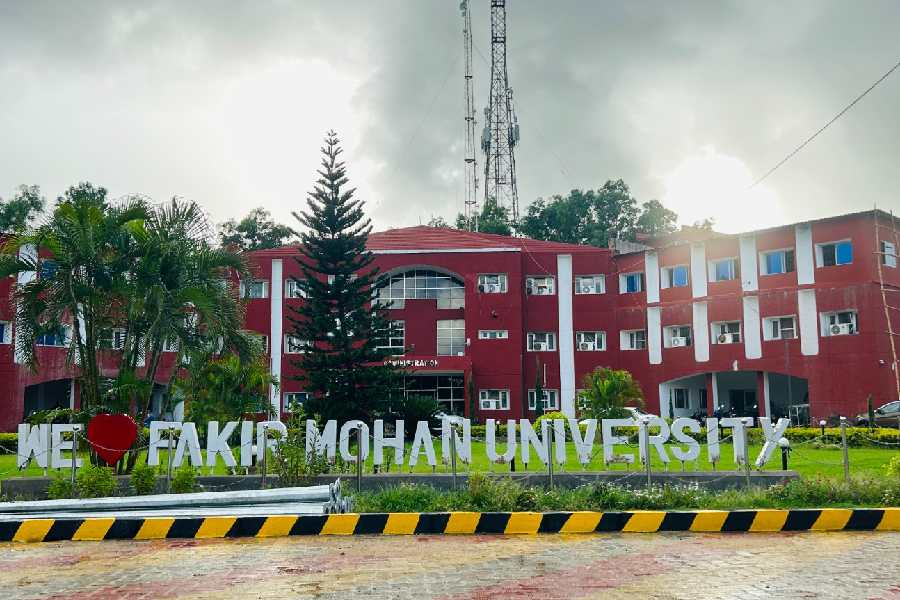 |
 |
 |
| The personal effects of Acharya Prafulla Chandra Ray on the mezzanine floor of a room in Rajabazar Science College (picture top by Bishwarup Dutta); the room as it used to be in the 1940s (above); and the Acharya. |
On the first floor of Palit Building on the Rajabazar Science College campus at 92 Acharya Prafulla Chandra Road is a largish room, a section of which is a tiny laboratory with rather quaint-looking equipment.
A sturdy wooden ladder leads to a mezzanine floor in the same space. It turns out to be a tiny, rather spartan bedroom with two beds covered with transparent plastic sheets, a small cupboard containing an individual’s personal effects, a hat stand and a walking stick.
The furniture and other effects once belonged to the remarkable scientist and entrepreneur after whom this road, earlier known as Upper Circular Road, was renamed, and this is where Acharya Prafulla Chandra Ray, who was born in the same year as Rabindranath Tagore, spent the last days of his life. He died on June 17, 1944.
This happens to be the chemistry department of the institution which he had helped expand with generous contributions. But now the building with high ceilings and corridor with a row of arches does not have enough space for the man who had opened Bengal Chemicals in an inconspicuous building at 91 Upper Circular Road in 1892. This adjacent building, which once belonged to the Acharya, has now changed beyond recognition.
A photograph in the ABP archive shows the same furniture — a small table, a couple of chairs and a carved two-tier table on which he presumably kept his files, and a bed — but in a different arrangement. The room has a lived-in look.
The legend on the door to this room dubs it Acharya P.C. Ray Museum, and although it is certainly not worthy of the great scientist who was behind the spread of research in chemistry all over the country, it affords glimpses into his personal life. He had groomed a cluster of dynamic and illustrious disciples.
The Acharya, who served the Indian Chemical Society, had besides, discovered mercurous nitrate and written his authoritative History of Hindu Chemistry.
 |
 |
 |
| Bell jars, Precision Veriner and Electropode in the laboratory that Acharya PC Ray used when he lived at Science College. (Above) The signboard above the entrance to the museum. (Biswarup Dutta) |
He had varied research interests, ranging from isomorphism and chemical homology, chemical analysis of Indian foodstuff and kinetic aspects of chemical reactions.
The Ananda Bazar Patrika carrying his death news, quoted the Acharya as saying that when he joined Hare School, his classmates would deride him, calling him “Bangal” — as opposed to “Ghoti”, the ones who were born on the western half of this state. His misfortune was that he was born in Khulna district of East Bengal.
And like most Bengalis, he was a life-long victim of indigestion and bronchial problems. In his cupboard he stocked Hypocal, Adrenaline tartarate (dated 26.12.42.) to be used in an emergency, and Permidin-Hesperidin tablets, Pumilet medicated lozenge and Pep’s, quite popular even in the 1950s. Most of these brand names are unknown even to physicians today. Besides, there is a tin of Ovaltine, a tiny bottle of Dettol and ??????ampoules large enough to knock out a horse.
His glasses, dentures, spoons, Moradabadi vases, shoes, juicer and feeding cup are also on display. He used Bathgate’s hair oil, once very popular, and Monarch gem clip. The contents of a small jar with the label, Khadi Pratisthan 15 College Square, are not known, but this is expected of a man, who, fired by nationalistic zeal, endeavoured to harness the knowledge of ancient India to the modern methods of manufacturing medicines devised in the West.
Acharya P.C. Ray’s aims may have been noble but besides a few leaders like Netaji, Dr BC Roy and Nehru, few appreciated his achievements, and he had to resign from Bengal Chemicals owing to differences with the director. He suffers the same neglect today











